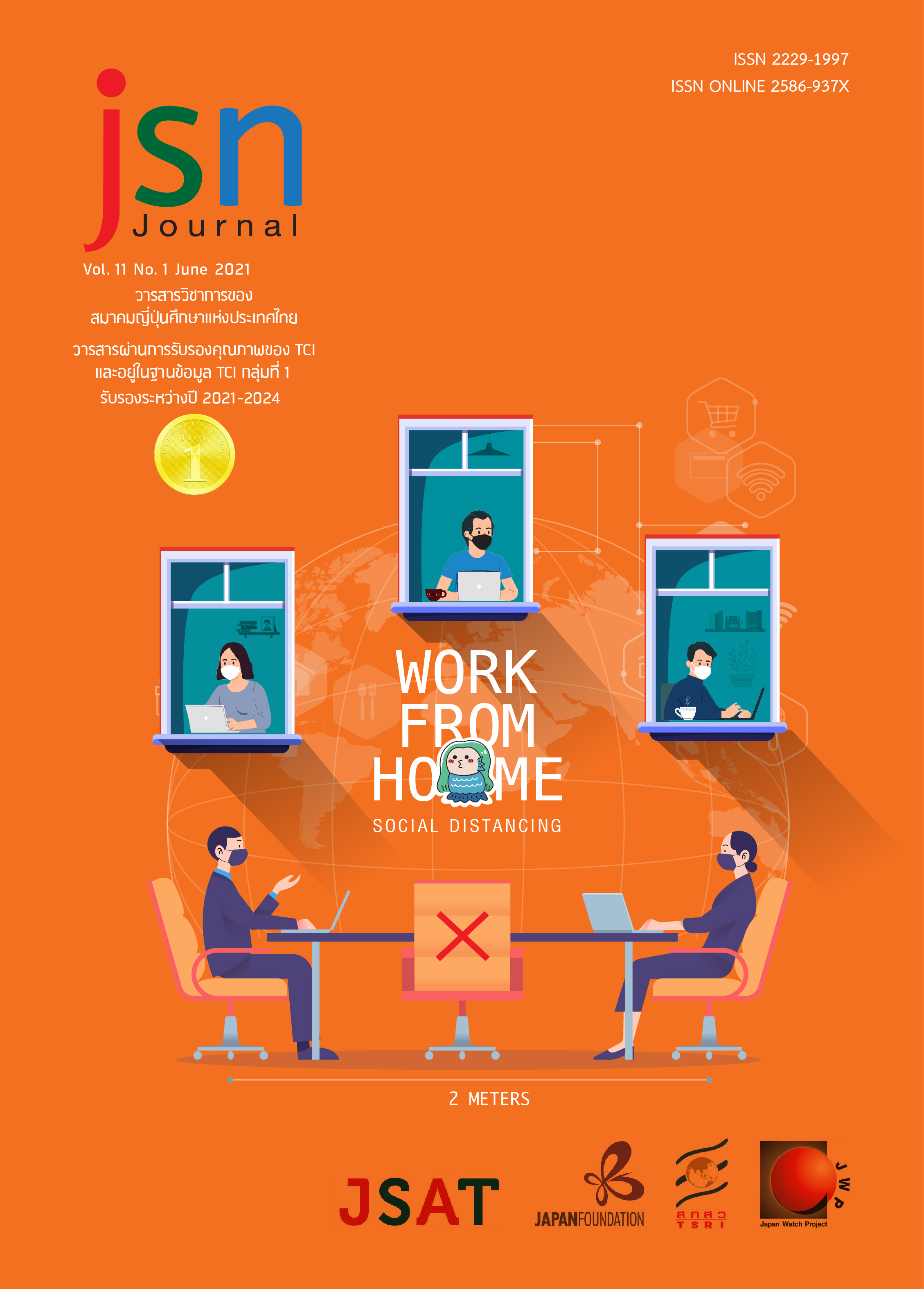The Development of a Self-efficacy Scale for Japanese Language Assistants and Its Validation through a Longitudinal Survey: Targeting “NIHONGO Partners” dispatched to Thailand
Main Article Content
Abstract
The purpose of this study is to create a scale of self-efficacy (SE) for Japanese assistants. Focusing on Thai secondary schools which have a large number of Japanese learners in Southeast Asia, we conducted a questionnaire survey of “NIHONGO Partners” (NP), Japanese language assistants. Five factors were extracted: “positive communication,” “enthusiasm for the class,” “relationship with teacher,” “optimistic personality,” and “recognition of ones position as NP.” Moreover, as a result of conducting a longitudinal survey at the start, mid-term, and end of the dispatch to examine changes as the period of dispatch progressed, “positive communication,” “enthusiasm for the class,” and “recognition of ones position as NP,” dropped a little bit at the mid-term. But these factors increased in the end, while the category, “optimistic personality,” continued to increase from the start to finish. These factors suggest that SE increased due to experience. On the other hand, the “relationship with teacher” dropped significantly at the mid-term, and further decreased at the end compared to what it was at the start. Among the reasons, it was found that the average value of one of the subordinate items, “make a firm meeting with CP (counterpart, the Thai Japanese teacher) beforehand” was low. This scale is considered to be useful and versatile, satisfying the requirements of reliability and validity and shows a stepwise change.
Article Details

This work is licensed under a Creative Commons Attribution-NonCommercial-NoDerivatives 4.0 International License.
ข้อความและข้อคิดเห็นต่างๆ ในบทความเป็นของผู้เขียนบทความนั้นๆ ไม่ใช่ความเห็นของกองบรรณาธิการหรือของวารสาร jsn Journal
References
Bandura, A. (1977). Self-efficacy: Toward a unifying theory of behaviour change. Psychological Review. 84, 191-215.
Furubeppu, H. (2009). Daigaku nihongo kyoin yosei ni okeru kaigai nihongo ashisutanto no seicho: PAC bunseki to han-kozouka mensetsu niyoru yoki nihongo kyoshi no henka wo chushin ni [The Development of Japanese teaching assistants overseas in a university TJSL Course: Focusing on change in image of a good Japanese teacher using PAC (Personal Attitude Construct) analysis and semi-structured interviews] Journal of Japanese Language Teaching, 143, 60-71.
Furubeppu, H. (2018). Eigo-ken chutoo kyoiku-kikan nihongo kyoshi ga nihongo ashisutanto ni motomeru shishitsu: Gogaku ashisutanto keiken no umu ga nihongo kyoshi no ishiki ni oyobosu eikyo nitsuite no kento [Behavioral characteristics of good Japanese language assistants from the standpoint of secondary school Japanese language teachers in the English zone: the influence of the language assistant’s experience on the perspective of Japanese language teachers] Journal of Japanese Language Teaching, 170, 107-121.
Higuchi, K. (2014). Shakai chosa no tameno keiryo tekisuto bunseki: Naiyo bunseki no keisho to hatten wo mezashite [Analytical text analysis for social research: Aiming at succession and development of content analysis. ] Nakanishiya Shuppan.
Itano, Y. & Maeda, M. (2002). Serufu efikashi no rinshoo shinri-gaku [Clinical psychology of self-efficacy.] Kita-ooji Shobo.
Ito, T. (1996). Gakushu tassei bamen ni okeru jiko-koryokukan, geninkizoku, gakushu-horyaku no
kankei [Self-efficacy, causal attribution and learning strategy in an academic achievement situation] The Japanese Journal of Educational Psychology, 33(1), 34-49.
Japan Foundation (2017). Kaigai no nihongo kyoiku no genjo 2015 nendo nihongo kyoiku kikan chousa yori [Survey report on Japanese-language education abroad, 2015.] Retrieved from https://www.jpf.go.jp/j/project/japanese/survey/result/survey15.html
Japan Foundation (2020). Kaigai no nihongo kyoiku no genjo 2018 nendo nihongo kyoiku kikan
chousa yori [Survey report on Japanese-language education abroad, 2018.] Retrieved from https://www.jpf.go.jp/j/project/japanese/survey/result/survey18.html
Japan Foundation Asian Center (2020). Kore made no haken jisseki, “NIHONGO Partners” tte?
[Past dispatch record: What is “NIHONGO Partners”?] , Retrieved from https://jfac.jp/partners/overview/achievements/
Karakisawa, M. (2010) JSL-jido ga “Kaku” katudo ni sankasuru tame no nihongo shien
“posuta-katudo” no shien jissen kara [From the support practice of Japanese language
support "poster activity" for JSL children to participate in "writing" activity.] Journal for Children Crossing Borders, 1, 23-45.
Manabe, E., Sasagawa, H., Matsuda, K., Kitajima, K., Sonoda, E., Taneike, R., Ueno, N., (2007) Kango
gakusei no rinchi jisshu jiko kooryoku kan no kaihatsu to sono shinraisei datoosei no kentoo [Development of a Self-Efficacy Scale for Nursing Students during Clinical Training and an Assessment of its Reliability and Validity.] Journal of Japanese Society of Nursing Research, 30, (2), 43-53.
Nakayama, E. (2016) Tai ni okeru Nihongo kyoushi kan no kyodo moderu no sai-kochiku-nihongo
bogo-washa kyoushi eno intabyu chousa ni motoduite [Reconstruction of the Model of Collaboration among Japanese Language Teachers in Thailand: Based on Interviews with the Japanese Native Speaker Teachers.] Journal of Osaka Sangyo University (28), 75-91.
Oka, Y (2016) Nihongo gakkousei no gakushu doki ni kansuru kenkyu: Kitai, kachi, gakushu konnan
ishiki no kankei [The relationship between expectations, values and awareness of learning disabilities.] Journal of Studies in Japanese Language and Japanese Language Teaching, 7, 229-244.
Pintrich, P.R., & De Groot, E.V. (1990) Motivational and self-regulated learning components of classroom academic performance. Journal of Educational Psychology, 82, 33-40.
Takeuchi, O. & Mizumoto, A. (2014). Gaikokugo kyoiku kenkyu hando bukku kaitei-ban [Foreign language education and research handbook revised edition.] Shohakusha.


